Submitted:
30 August 2023
Posted:
31 August 2023
You are already at the latest version
Abstract
Keywords:
1. Introduction
2. Role and Responsibilities of Relevant Actors
| Voltage Level | Operator |
| ≥ 154kV | ISO (KPX) |
| 70kV and 22.9 kV Dedicated transmission line |
TO (KEPCO) |
| ≤ 22.9kV distribution line | DSO (KEPCO) |
3. Overall Prequalification Scheme of DSO on Market Participation of DERA
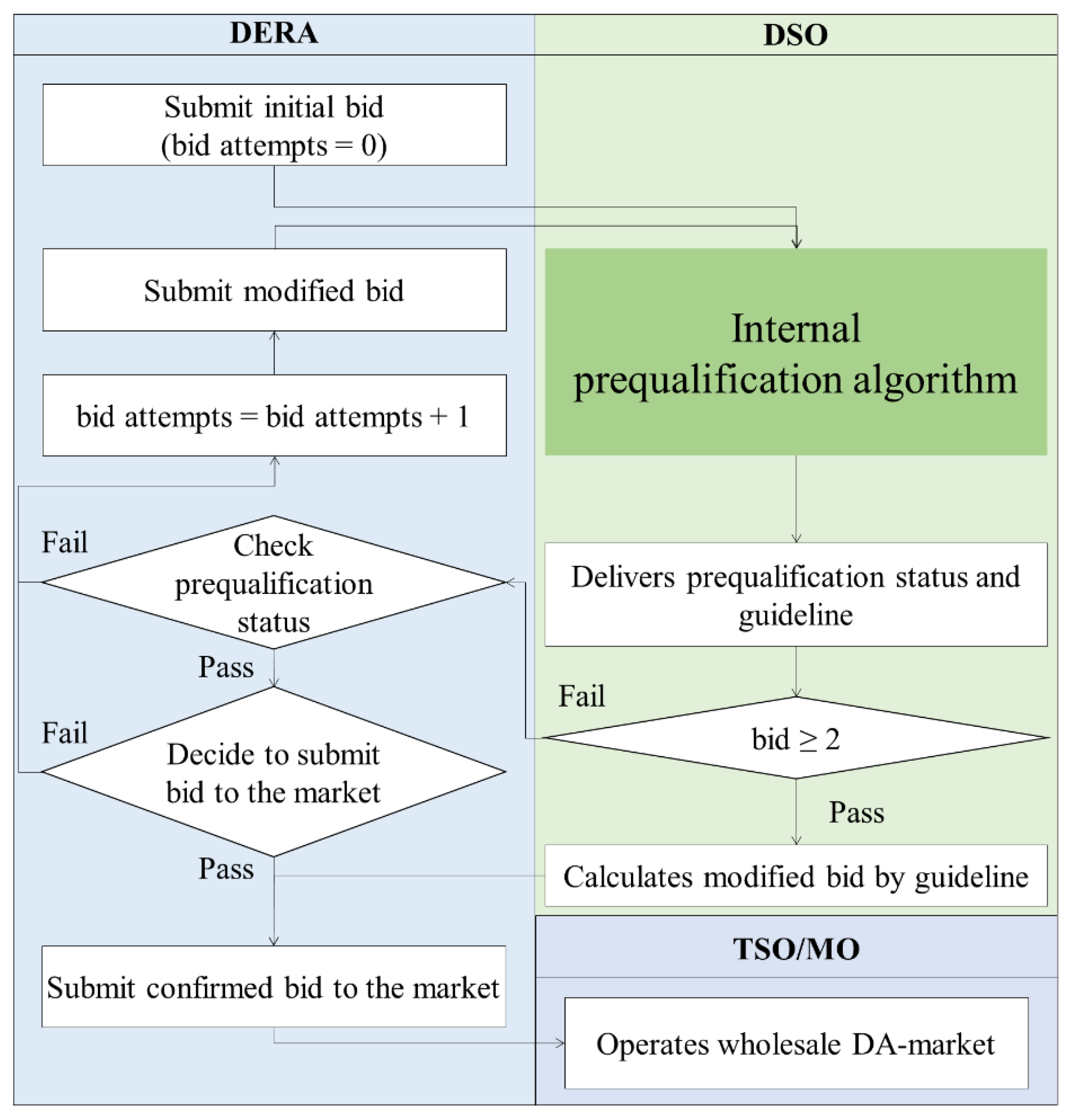
- 1)
- Submission of initial bids to DSO by DERA
- 2)
- Execution of internal prequalification algorithm of DSO
- 3)
- Iteration of DERA’s bid modification and DSO’s re-prequalification under the bid-modification-guidelines
- 4)
- Start of existing transmission-level wholesale market with the qualified bids of DERAs
4. Efficient Prequalification Algorithm of DSO based on Robust Optimization
| Sets and Indices | |
| Subscripts for buses | |
| Subscripts for lines | |
| Subscripts for risky buses and lines | |
| Subscripts for DER and DERA | |
| Subscripts for iterations | |
| Set of buses and lines | |
| Set of overvoltage, undervoltage risky buses and upper overflow, down overflow risky lines | |
| Set of DER, storage, and DER with reserve of DERA a on bus i | |
| Set of DERA | |
| Set of result of power flow, worst overvoltage state, worst undervoltage state, worst upper overflow state, worst down overflow state and revised bidding in iteration s | |
| Parameters | |
| Conductance and susceptance of the line between bus i and j [p.u.] | |
| Upper and lower limit of the voltage magnitude [p.u.] | |
| Upper rate capacity of line l [p.u.] | |
| Rate capacity of DER t [p.u.] | |
| Increase and decrease controllable amount of DRES t [p.u.] | |
| Active and reactive power of DRES t in initial bidding of CVPP [p.u.] | |
| Ramp up and down reserve power of DRES t in initial bidding of CVPP [p.u.] | |
| Upper and lower active power of DRES t in initial bidding of CVPP [p.u.] | |
| Demand forecast of bus i [p.u.] | |
| A lower limit of the power factor | |
| Upper and lower uncertainty range of output of DER t [p.u.] | |
| Upper and lower uncertainty range of demand forecast of bus i [p.u.] | |
| Overvoltage and Undervoltage violation on bus i of DERA a in iteration s [p.u.] | |
| Upper overflow and down overflow violation on line l of DERA a in iteration s [p.u.] | |
| Overvoltage magnitude sensitivity of active and reactive power on bus j to bus i to in iteration s at overvoltage worst case | |
| Undervoltage magnitude sensitivity of active and reactive power on bus j to bus i to in iteration s at undervoltage worst case | |
| Squared complex flow sensitivity of active and reactive power on bus k to line l to in iteration s at upper overflow worst case | |
| Squared complex flow sensitivity of active and reactive power on bus k to line l to in iteration s at down overflow worst case | |
| Allocation factor of overvoltage and undervoltage violation on bus i of DERA a in iteration s | |
| Allocation factor of upper and down overflow violation on line l of DERA a in iteration s | |
| Criteria of overvoltage security, overflow security and convergence of bid revision | |
| Decision Variables | |
| Active and reactive power of DER t in iteration s [p.u.] | |
| Ramp up and ramp down reserve power of DER t in iteration s [p.u.] | |
| Upper and lower active power of DER t in iteration s [p.u.] | |
| Adjustment of active and reactive power of DER t in iteration s [p.u.] | |
| Adjustment of Upper and lower active power of DER t in iteration s [p.u.] | |
| Active and reactive injected power on bus i in iteration s [p.u.] | |
| Magnitude and angle of voltage on bus i in iteration s [p.u.] | |
| Forecast error rate of the DER output and demand on bus i in iteration s | |
| Complex, active and reactive power flow on line l in iteration s [p.u.] | |
| Angle of voltage between bus i and bus j or on line l in iteration s [p.u.] | |
| Dropout binary variable of DER t in iteration s | |
| Auxiliary Variables | |
| Absolute value of active and reactive power difference of DER t between initial bid and iteration s [p.u.] | |
| Absolute value of Ramp up and ramp down reserve power difference of DER t between initial bid and iteration s [p.u.] | |
| Active and reactive discharging power of storage DER t in iteration s [p.u.] | |
| Active and reactive charging power of storage DER t in iteration s [p.u.] | |
| Charging state binary variable of storage DER t in iteration s | |
| Binary Variables | |
| Forecast error rate of the DER output and demand on bus i in iteration s |
4.1. Original formulation for prequalification
- DSOs are regulated entities and strive to be neutral, and as public entities, they strive to maximize social welfare;
- The load is inflexible and is supplied with electricity at a fixed tariff. It is important to note that this is not very different from the actual empirical environment in Korea;
- Only DERs based on renewable energy sources with zero-marginal-cost characteristics are connected to the distribution grid, and they are also price-takers.
4.2. Efficient prequalification algorithm implemented in field experiment
- Step 1: Selection of risky nodes and lines
- Step 2: Exploration of worst-case scenario considering uncertainty ranges
- Step 3: Check of grid constraint violation
- Step 4: Calculation of sensitivity matrix of each DERA and allocation of violation information
- Step 5: Calculation of maximum allowable bids based on sensitivity matrix and constraints violations
- Step 6: Check the convergence of modified bids
- Step 7: Additional calculation of upper and lower bounds for outputs of storage resources
4.3. Improvements in the implemented algorithm compared to previous work
- Equation (4b), (4d), (6), (8), (9b), (9d), (10b), and (10d)
- Equation (5c)
- Equation (13a)-(13d), (14a)-(14d), (15a)-(15d), and (16a)-(16h)
- Equation (17a)-(17j)
- Equation (18a)-(18h), (19a)-(19d), (20a), (20b), (21a), (21b), (22a)-(22d), (23a)-(23d), and (24)
- Equation (25a)-(25c)
- Equation (26a)-(26k), (27a)-(27d), (28a)-(28d), and (29a)-(29d)
- Others
5. Results of Field Experiment
5.1. System configurations
5.2. Scenario configuration
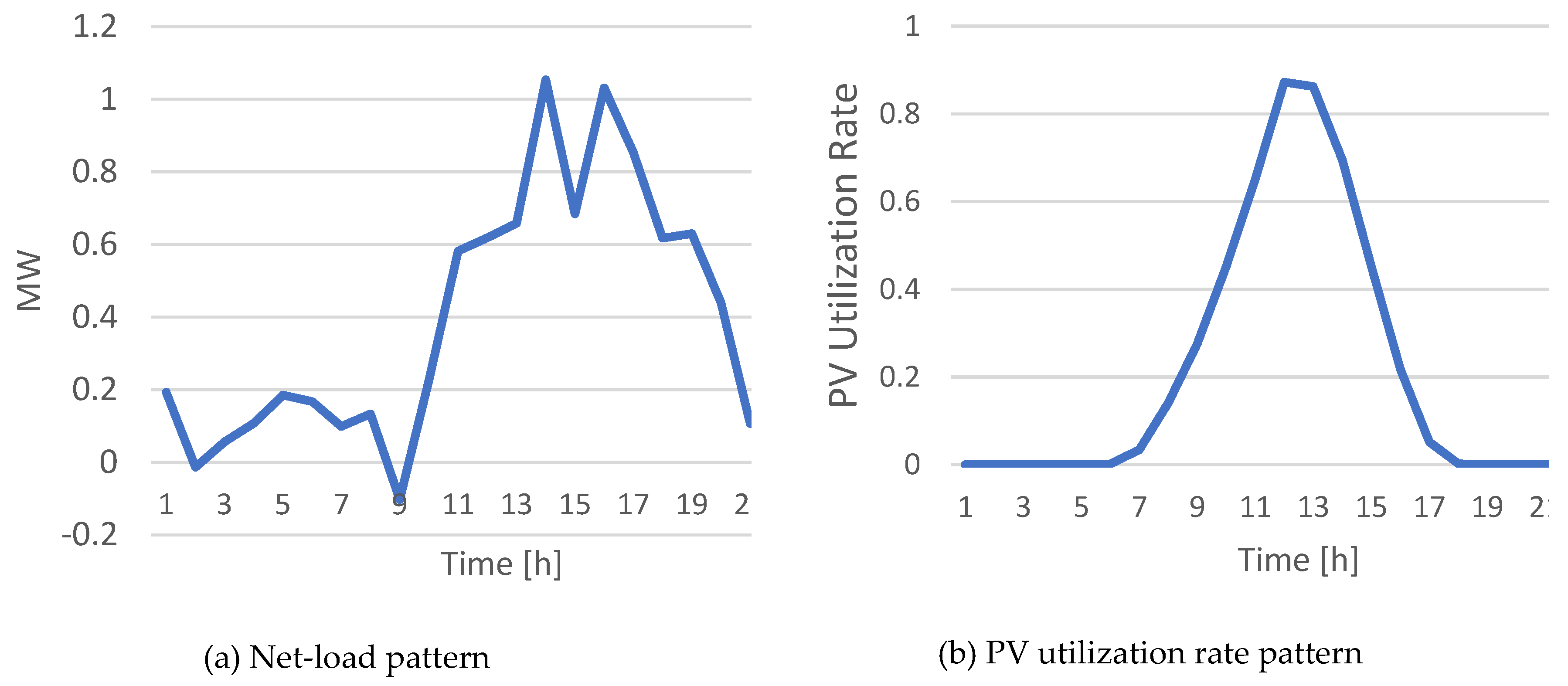
5.3. Verification of the proposed scheme
| DER Index |
DER Type |
Hour Index |
Max. Allowable Generation Power [kW] |
Max. Allowable Discharging Power [kW] |
Max. Allowable Charging Power [kW] |
| 15 | ESS | 11 | - | -1,909.22 | -1,940.00 |
| 16 | ESS | 11 | - | 970.00 | -970.00 |
| 23 | ESS | 11 | - | -1,940.00 | -1,940.00 |
| 24 | ESS | 11 | - | -43.71 | -485.00 |
| 27 | PV | 11 | 8.77 | - | 0 |
| 33 | ESS | 11 | - | 1,940.00 | -1,940.00 |
| 34 | ESS | 11 | - | 1,746.00 | -1,746.00 |
| 40 | ESS | 11 | - | 0 | -1,940.00 |
| 41 | PV | 11 | 746.10 | 0 | 0 |
| 45 | PV | 11 | 17.91 | 0 | 0 |
| 46 | PV | 11 | 25.37 | 0 | 0 |
| 47 | PV | 11 | 454.26 | 0 | 0 |
6. Conclusions
Author Contributions
Funding
Acknowledgments
Conflicts of Interest
References
- Ismael, S. M.; Abdel Aleem, S. H. E.; Abdelaziz, A. Y.; Zobaa, A. F. State-of-the-ort of hosting capacity in modern power systems with distributed generation. Renewable Energy, 2019, 130, 1002–1020. [Google Scholar] [CrossRef]
- Karimi, M.; Mokhlis, H.; Naidu, K. , Uddin, S.; Bakar, A.H.A. Photovoltaic penetration issues and impacts in distribution network – A review. Renewable and Sustainable Energy Reviews, 2016, 53, 594–605. [Google Scholar] [CrossRef]
- Mohammadi, P.; Mehraeen, S. Challenges of PV integration in low-voltage secondary networks. IEEE Transactions on Power Delivery, 2017, 32, 525–535. [Google Scholar] [CrossRef]
- US Federal Energy Regulatory Commission. FERC Order No. 2222: Participation of Distributed Energy Resource Aggregations in Markets Operated by Regional Transmission Organizations and Independent System Operators, Washington D.C., United States, 2020.
- The European Parliament and The Council of The European Union. Regulation (EU) 2019/943 of the European Parliament and of the Council of 5 June 2019 on the Internal Market for Electricity. Off. J. Eur. Union.
- The European Parliament and The Council of The European Union. Directive (EU) 2019/944 of the European Parliament and of the Council of 5 June 2019 on common rules for the internal market for electricity and amending Directive 2012/27/EU. Off. J. Eur. Union. 2019, 158, 125–199.
- Koraki, D.; Strunz, K. Wind and solar power integration in electricity markets and distribution networks through service-centric virtual power plants. IEEE Transactions on Power Systems, 2018, 33, 473–485. [Google Scholar] [CrossRef]
- Edmunds, C.; Galloway, S.; Elders, I.; Bukhsh, W.; and Telford, R. Design of a DSO-TSO balancing market coordination scheme for decentralised energy. IET Gener. Transm. Distrib., 2020, 14, 707–718. [Google Scholar] [CrossRef]
- Moon, H.S.; Jin, Y.G.; Yoon, Y.T.; Kim, S.W. Prequalification Scheme of a Distribution System Operator for Supporting Wholesale Market Participation of a Distributed Energy Resource Aggregator. IEEE Access, 2021, 9, 80434–80450. [Google Scholar] [CrossRef]
- Jeong, C.M.; Kim, S.W.; Park, J.S.; Yoon, Y.T.; Moon, H.S. Robust prequalification process of a distributed system operator considering N-1 contingency. IET Renew. Power. Gener. 2022, 16, 2694–2710. [Google Scholar] [CrossRef]
- Park, S.-Y.; Park, S.-. 2.; Son, S.-Y. Optimal VPP operation considering network constraints uncertainty of DSO. IEEE Access, 2023, 11, 8523–8530. [Google Scholar] [CrossRef]
- Gerard, H.; Rivero, E.; Six, D. Basic schemes for TSO-DSO coordination and ancillary services provision – D 1.3. (Version 1.1). Available online: https://smartnet-project.eu/publications/index.html#tab-id-2.
- Omie. Modelo de funcionamiento de los mercados locales de electricidad: Proyecto IREMEL. 2019. Available online: https://www.omie.es/sites/default/files/2019-12/modelo_de_funcionamiento_mercados_locales_electricidad_v2_0.pdf.
- Stevens, N.; Merckx, K.; Crucifix, P.; Gómez, I.; Santos-Mugica, M.; Díaz, Á.; Sanjab, A.; Kessels, K.; Rivero, E.; Mou, Y.; Ávila, J.P.C.; Lind, L.; Camacho, L.O.; Valarezo, O. D2.1 – Markets for DSO and TSO procurement of innovative grid services: Specification of the architecture, operation and clearing algorithms. (Version 1.0). 2021. Available online: https://private.coordinet-project.eu/files/documentos/6033b5fe475cdCoordiNet_WP2_D2.1_Markets%20for%20DSO%20and%20TSO%20procurement%20of%20innovative%20grid%20services_V1.0_20.02.2021.pdf.
- Küfeoğlu, S.; Kim, S.W.; Jin, Y.G. History of electric power sector restructuring in South Korea and Turkey. The Electricity Journal, 2019, 32, 106666. [Google Scholar] [CrossRef]
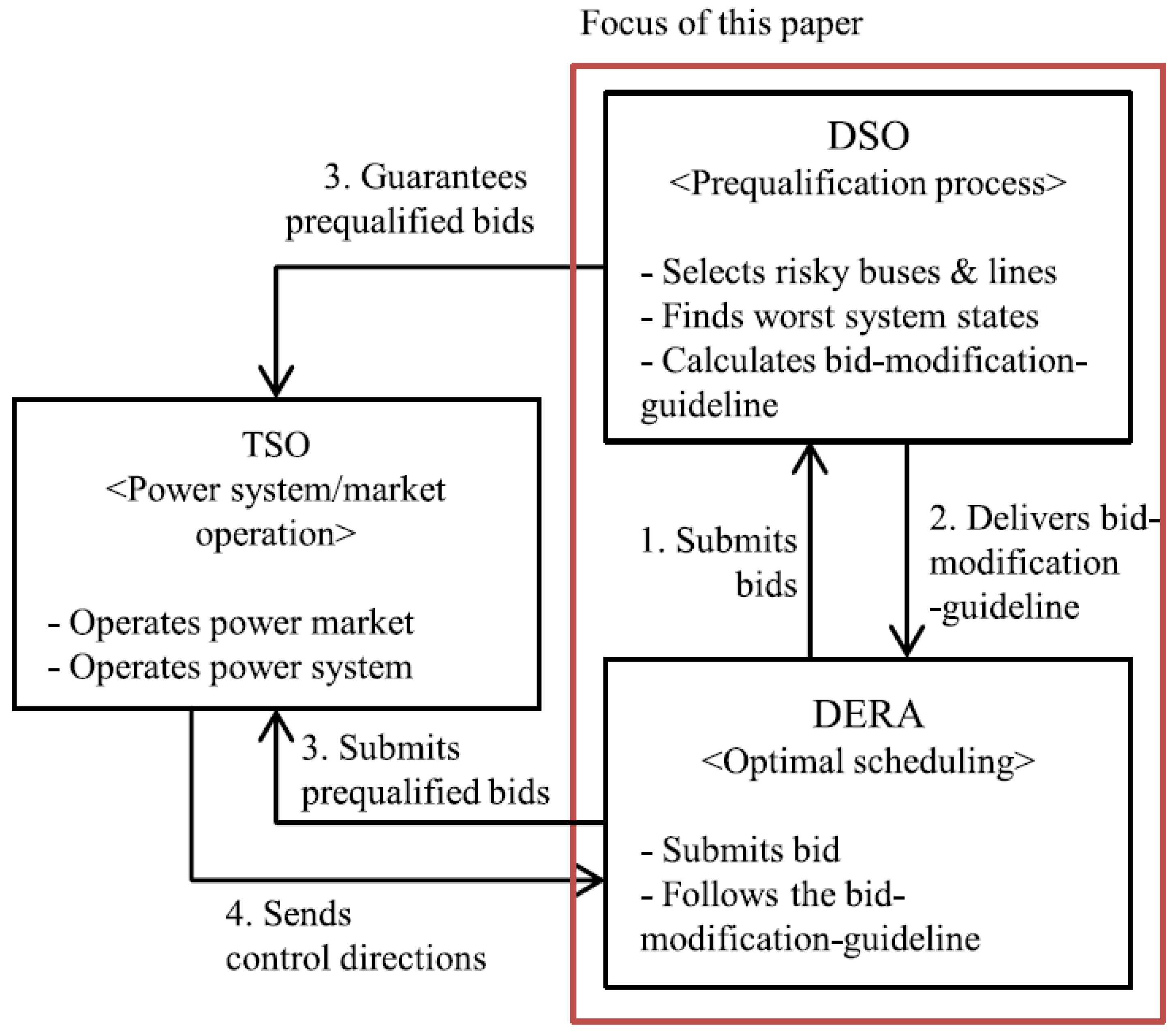
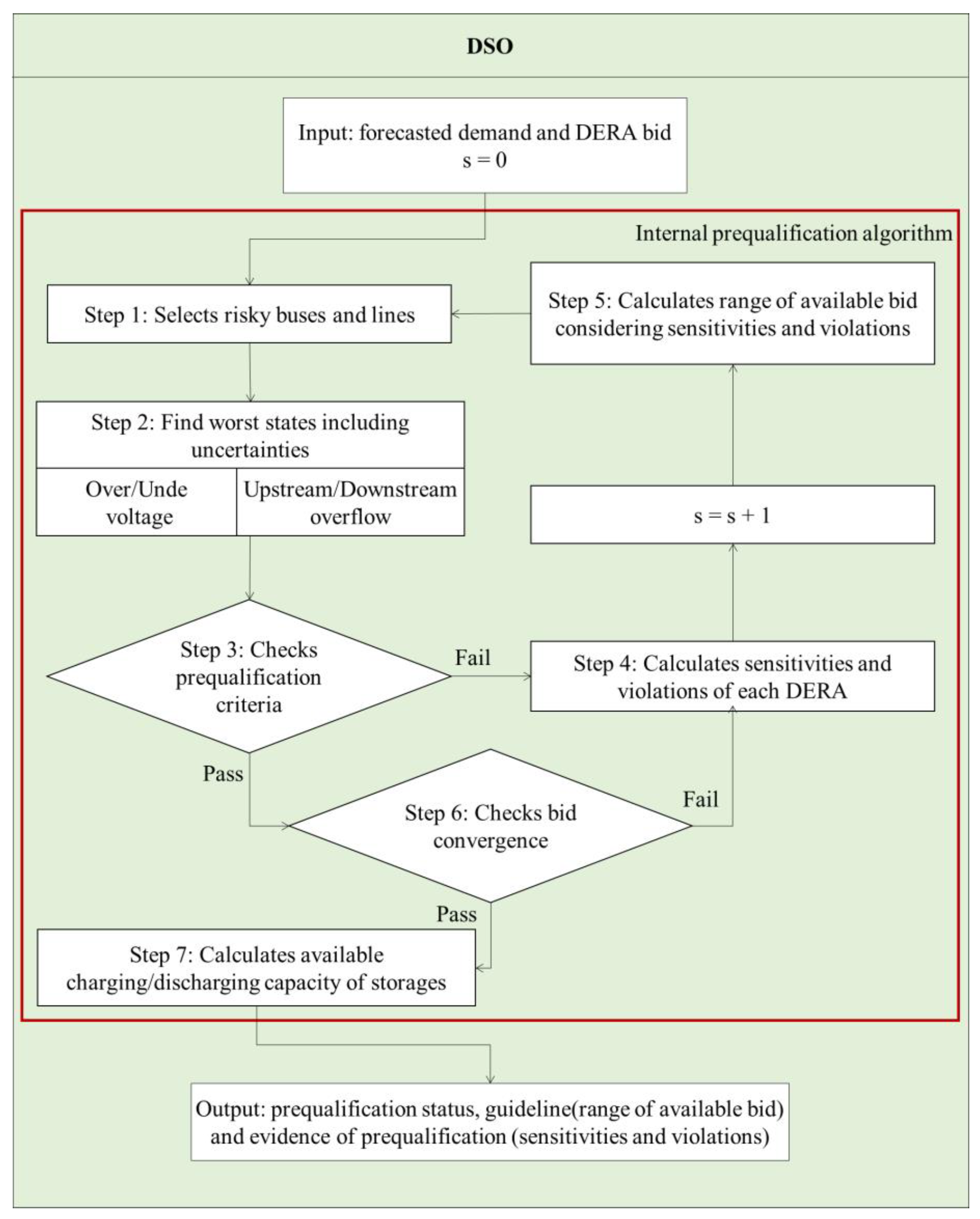
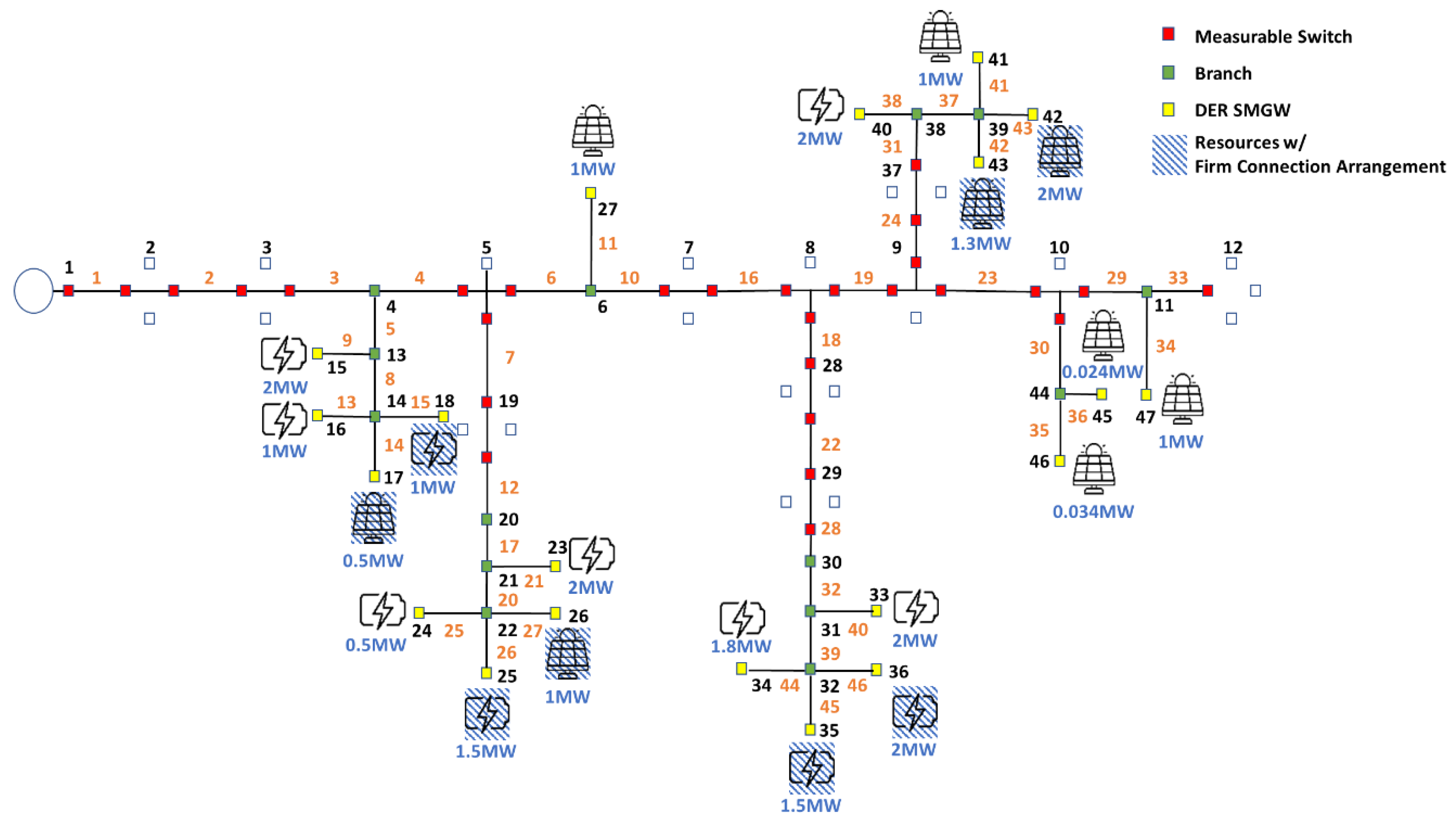
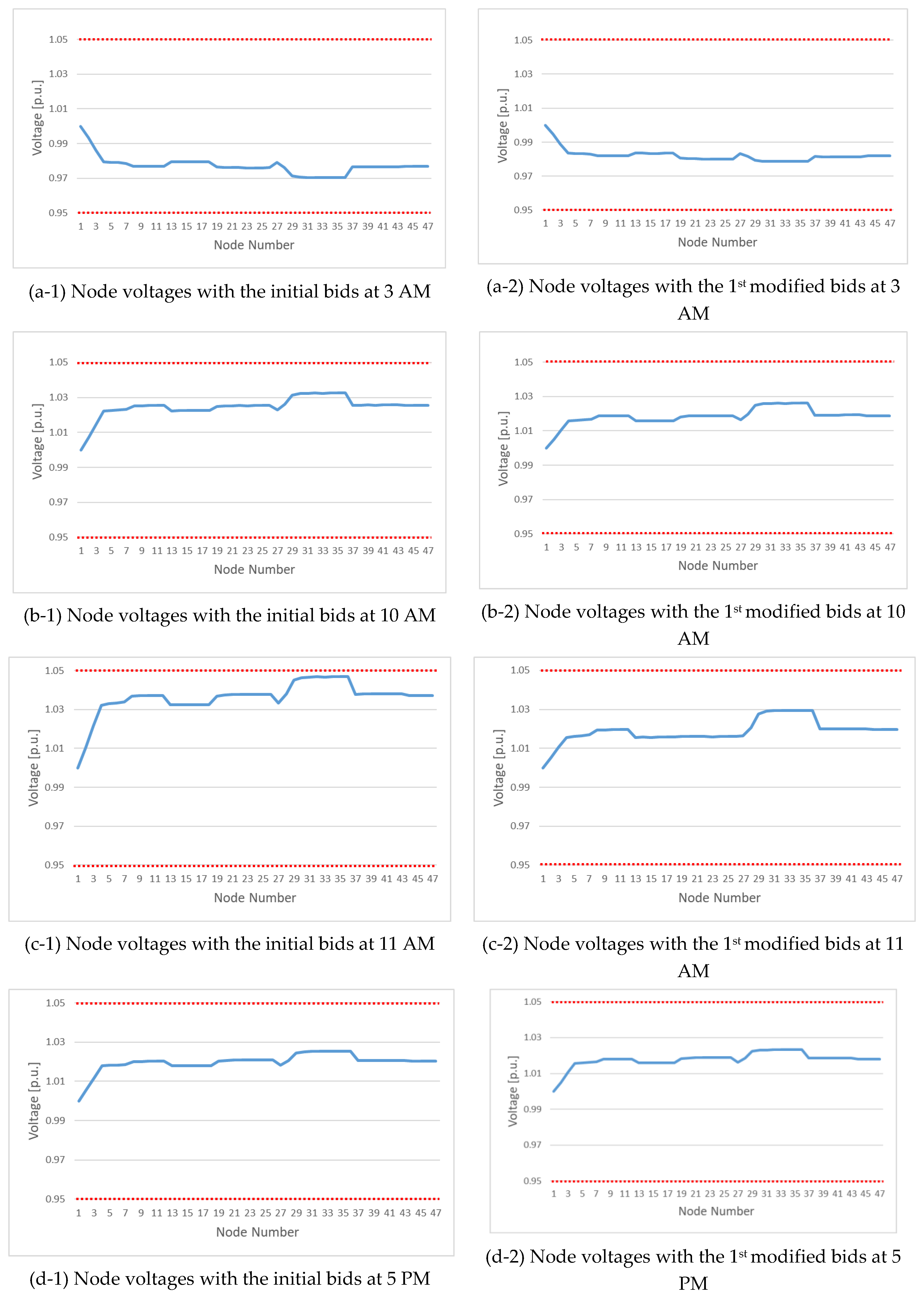
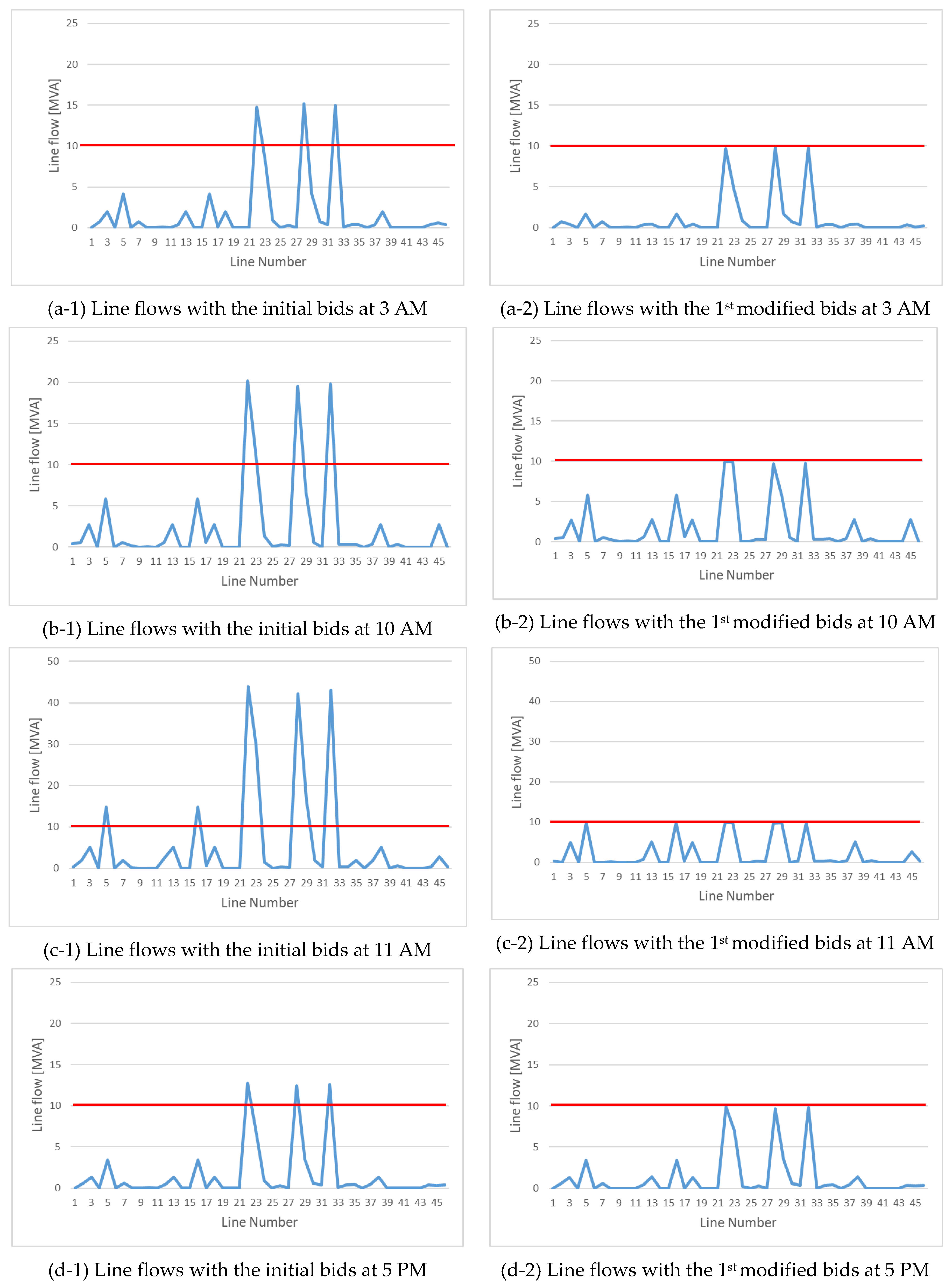
Disclaimer/Publisher’s Note: The statements, opinions and data contained in all publications are solely those of the individual author(s) and contributor(s) and not of MDPI and/or the editor(s). MDPI and/or the editor(s) disclaim responsibility for any injury to people or property resulting from any ideas, methods, instructions or products referred to in the content. |
© 2023 by the authors. Licensee MDPI, Basel, Switzerland. This article is an open access article distributed under the terms and conditions of the Creative Commons Attribution (CC BY) license (http://creativecommons.org/licenses/by/4.0/).





